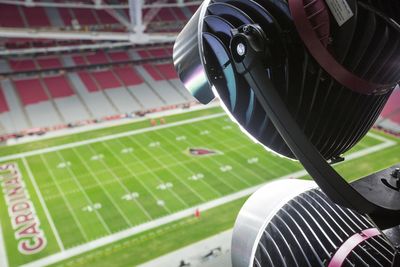Shedding New LED Light on Super Bowl XLIX

Joe Casper may not be able to illuminate “Deflategate,” but he believes his company’s efforts are going to bring new perspectives of Super Bowl XLIX for those in Glendale or watching the action at home.
This season, the University of Phoenix Stadium became the first NFL venue to be illuminated with high output LED Lighting. In addition to reducing energy usage by more than 75%, the Ephesus LED lighting system provides a much more even disrtribution of light throughout the playing surface. For the Super Bowl, Ephesus Lighting engineers calculate 250 foot candles of light on the playing surface – nearly 20% more than has ever been provided for an NFL game.
According to Casper, the founder and CTO of Ephesus Lighting, the increased level of light will serve to reduce glare and eliminate unwanted shadows. The improved uniformity will enable fans at the stadium and at home to upgrade their vantages. With traditional metal halide light, broadcasters need to keep adjusting the camera’s aperture and open as wide as possible to let enough light in. This limits the high-definition TV capabilities.
Casper said that with an assist from Ephesus, NBC will reduce the aperture size, and, in turn, increase the focal plane providing more depth of field and more detail. Additionally, blurry images emanating from cameras zooming in or showing a slow motion replay will be greatly mitigated.
Speaking of replay, the not so instant version has certainly impacted the playoff fortunes of the Detroit Lions and their tamers, the Dallas Cowboys. Casper said the advances in LED lighting will aid referees and league playoff officials at Super Bowl XLIX by providing the clearest pictures ever from an NFL game.
“The way we are lighting the field for Super Bowl XLIX will allow NBC cameras to get more clarity and a greater depth of focus,” said Casper. “As a result they will be able to zoom in tighter on replays and super slow motion without the flicker-effect or blurriness that is often associated with zooming in. This should help replay officials have the best possible pictures to make the right call.”
Casper said Ephesus' game plan for LED lighting centered on a trio of tenets.
“When we went into the sports LED lighting business we wanted to focus on three attributes,” he said. “We wanted to improve player performance, give the fans at home and at the game a better experience, and reduce energy usage. The ability to help referees make the right call is an added benefit that may help change the outcome of a game for the better one day.”
Given the way things have gone for the NFL on and off the field this season, one can certainly hope so.
The Ephesus system also carries other benefits. NBC, if it desires, can trigger an in-stadium light show or have the lights chase each other and “do the wave” around the venue. Moreover, Casper said Ephesus will function as a prevent defense of sorts to what happened in the Superdome with the 2013 Big Game, maintaining there won’t be a 20-minute delay if there is a power disruption. Rather, he says, the lights will flip right back on.
Regardless of the outcome on the field, Casper thinks broadcasters and stadium operators will look back at Super Bowl XLIX as the day the lights went on for new ways to showcase American sports. “Every new stadium and arena will feature LED lighting,” he said, adding that over the next five years half of extant sporting structures will make a similar conversion.
Casper said Ephesus is in discussions with a number of new venues about its LED system.
Multichannel Newsletter
The smarter way to stay on top of the multichannel video marketplace. Sign up below.



